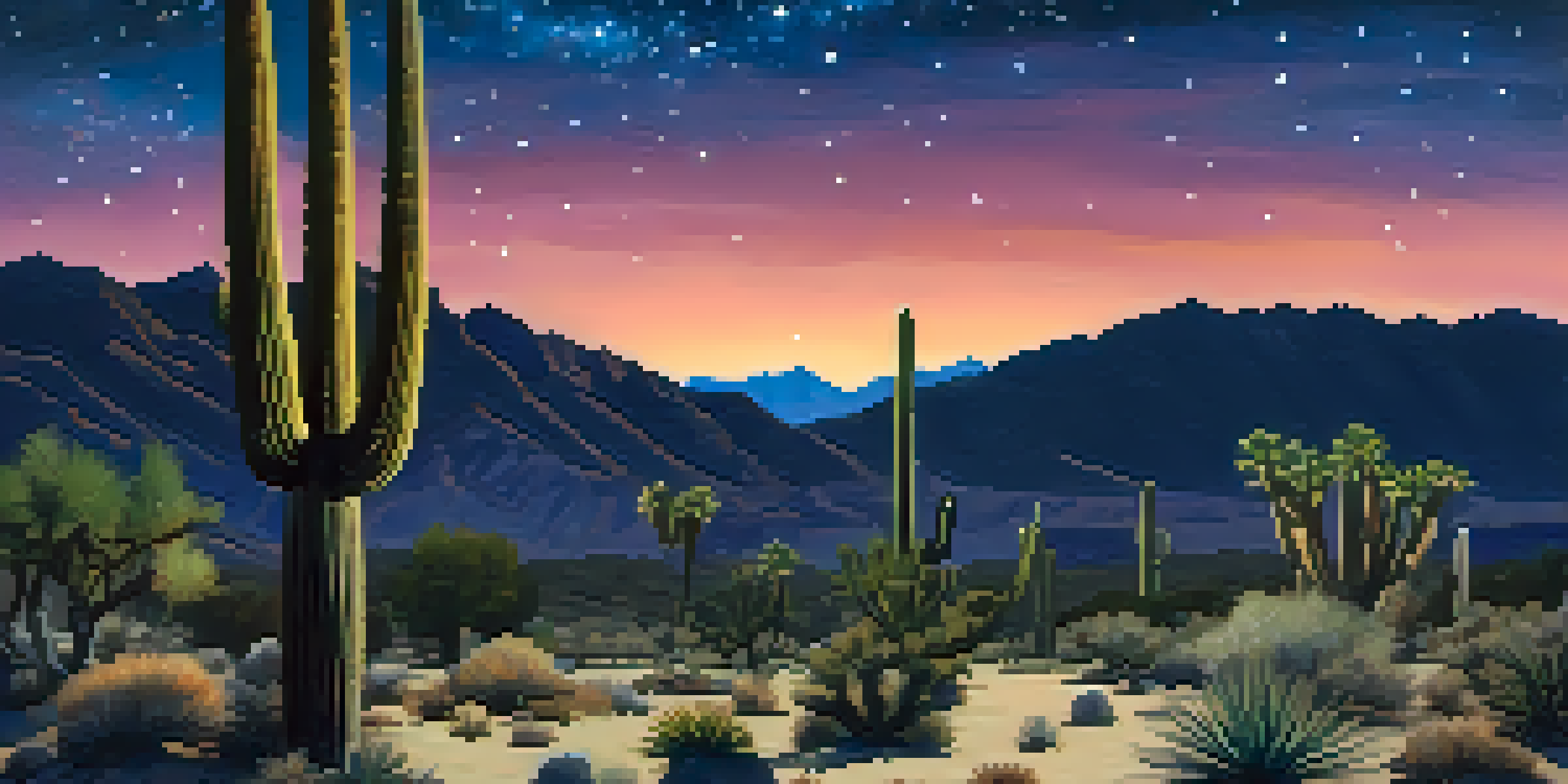Night Photography Techniques for Palm Springs Desert

Understanding the Unique Desert Night Sky
Palm Springs offers a breathtaking night sky, unlike any other. With minimal light pollution, the stars shine brighter and the Milky Way is often visible. This unique environment is perfect for capturing stunning astrophotography shots that evoke a sense of wonder.
The night sky is a miracle of infinitude.
To appreciate this celestial canvas, it's important to familiarize yourself with the constellations and the phases of the moon. Using apps like Star Walk or Skyview can help you identify stars and plan your shooting schedule around optimal moonlight conditions.
Remember, the magic of the desert night sky is not just in the stars but also in the way the landscape interacts with them. Incorporating elements like cacti or rock formations in your foreground can create a captivating juxtaposition between the earth and the cosmos.
Essential Camera Settings for Night Photography
Getting the right camera settings is crucial for night photography success. Start with a wide aperture (like f/2.8) to allow as much light as possible into the camera. This is especially important in the desert, where the light can fade quickly after sunset.

A longer exposure time is also key. Experiment with shutter speeds ranging from 15 to 30 seconds, depending on the amount of available light and desired effect. Just remember to use a tripod to keep your camera steady during those lengthy exposures.
Capturing the Desert Night Sky
Palm Springs offers stunning night skies perfect for astrophotography, enhanced by minimal light pollution and unique landscape features.
Additionally, setting your camera to a higher ISO can help capture more detail. However, be cautious; too high an ISO can introduce noise, which can detract from your beautiful night shots. Finding the right balance between ISO, aperture, and shutter speed is essential!
Choosing the Right Location in Palm Springs
Palm Springs is filled with incredible spots for night photography, but choosing the right location is key. Look for areas with minimal light interference, like the Coachella Valley Preserve or Joshua Tree National Park, where the desert's natural beauty can shine through.
Photography is the story I fail to put into words.
Consider the composition of your shots as well. Locations with interesting foreground elements, such as unique rock formations or desert flora, can add depth to your images. Don't forget to scout these locations during the day to plan your compositions effectively.
Timing is also important. Arrive early to set up and capture the transition from twilight to night, which can create stunning gradient skies. This can add a dynamic element to your photos that draws the viewer in.
Using Light Painting Techniques
Light painting is a fun and creative technique that can add a unique touch to your night photography. This involves using a portable light source, like a flashlight or LED light, to illuminate subjects or create patterns during a long exposure shot.
To get started, set your camera to a long exposure mode and experiment with different light sources. You can highlight specific features of the desert landscape or even draw shapes in the air to create abstract images.
Mastering Camera Settings
Achieving great night photos requires careful camera settings, including wide apertures, long exposure times, and balanced ISO levels.
Remember to practice beforehand, as timing and coordination are crucial. With a little creativity, light painting can transform ordinary night shots into extraordinary works of art that showcase your personal style.
Incorporating Foreground Elements in Your Shots
Including foreground elements in your night photography can enhance the overall composition and draw the viewer's eye into the scene. In the Palm Springs desert, consider using iconic desert plants like cacti or unique rock formations as focal points.
These elements not only provide context but also create a sense of depth in your images. Positioning them strategically in the frame can help guide the viewer's gaze from the foreground to the expansive sky above.
Experiment with different angles and perspectives to find the most compelling compositions. Sometimes, getting low to the ground can yield stunning results, revealing the intricate details of the desert while capturing the starry backdrop.
Editing Night Photos for Maximum Impact
Post-processing is an essential step to bring out the best in your night photography. Programs like Adobe Lightroom or Photoshop allow you to adjust exposure, contrast, and colors to enhance the mood of your images.
When editing, focus on bringing out the details in the shadows without losing the highlights of the stars. This balance can help create a more dynamic range, making your photos pop with life.
Safety Tips for Desert Photography
Prioritizing safety is essential when photographing in the desert at night, so be prepared with essentials and stay aware of your surroundings.
Additionally, consider using noise reduction tools to clean up any graininess that may have occurred due to high ISO settings. A little editing can go a long way in transforming your night shots into stunning visual stories.
Safety Tips for Night Photography in the Desert
While the allure of night photography is captivating, safety should always come first. The desert can be unpredictable, so ensure you take precautions, such as bringing enough water, snacks, and a first aid kit for emergencies.
It's also wise to inform someone of your plans, especially if you're heading to remote locations. Cell phone reception can be spotty, so consider bringing a portable charger and a reliable flashlight to navigate safely in the dark.

Lastly, be aware of your surroundings. Wildlife is active at night, and some areas may have potential hazards. Staying alert will help ensure a safe and enjoyable photography experience under the starry skies.